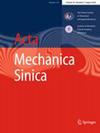Response of wind turbine loads to multi-scale turbulent structures: a study based on turbulence signals observed in the field
Abstract
Accurately assessing the impact of turbulence structures on load fluctuation is crucial for the long-term stable operation of wind turbines. Based on turbulence signals observed at the Qingtu Lake Observed Array in China, the aerodynamic load responses of the wind turbine to different turbulence scales are quantitatively analyzed in this study. The results indicate that very large-scale motions (VLSMs) are associated with significant load fluctuations due to its low frequency and high energy characteristics, increasing the risk of extreme loads. Large-scale motions coupled with the natural frequency of wind turbines in the medium frequency range, result in resonance phenomena. Small-scale motions, due to their high-frequency rapid vibration characteristics, cause instantaneous oscillations in wind turbine loads. Furthermore, correlation analysis indicates that the flapwise moment and thrust are most sensitive to VLSMs, while the edgewise moment is less affected by the scale characteristics. It is worth noting that this study is the first to explore the modulation effects of different scales of turbulent structures on the amplitude of wind turbine load fluctuation. It was found that turbulent structures exceeding a scale of 3δ have the most significant impact on modulating the load amplitudes, where δ is the boundary layer thickness, which is 99% of the flow velocity outside the boundary layer. These findings contribute to the enhancement of understanding regarding the load response of wind turbines in multi-scale turbulent environments and provide important references for the optimization of wind turbine design and load control.

 求助内容:
求助内容: 应助结果提醒方式:
应助结果提醒方式:


